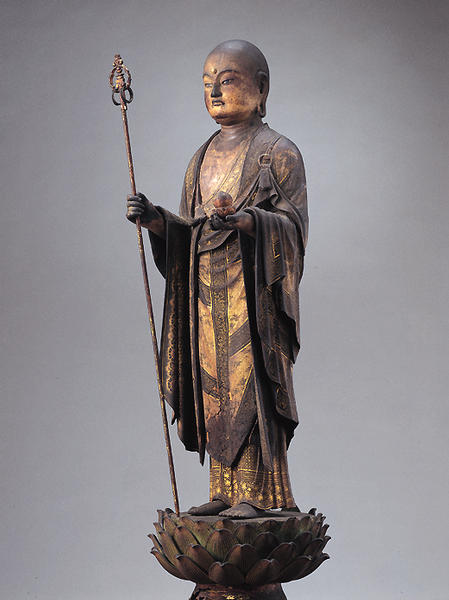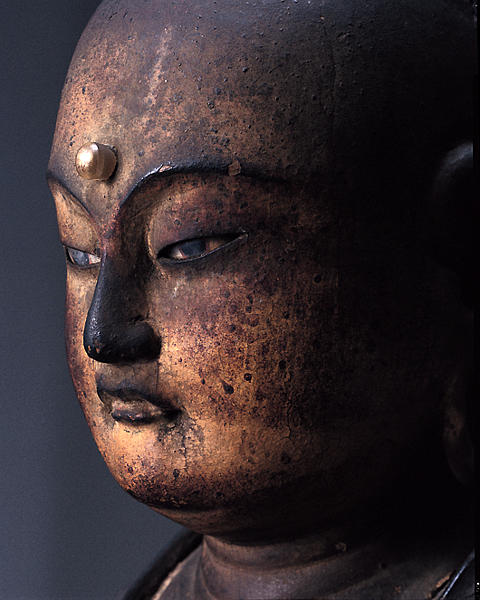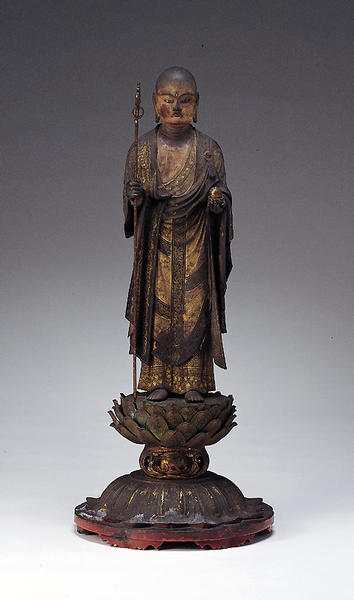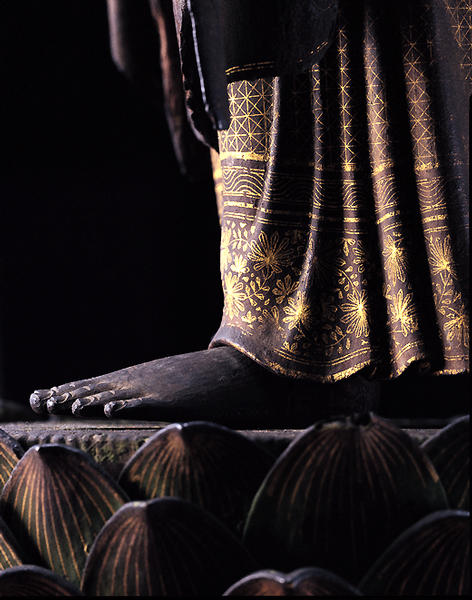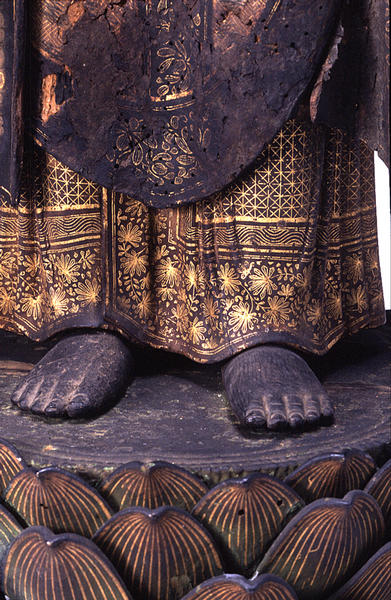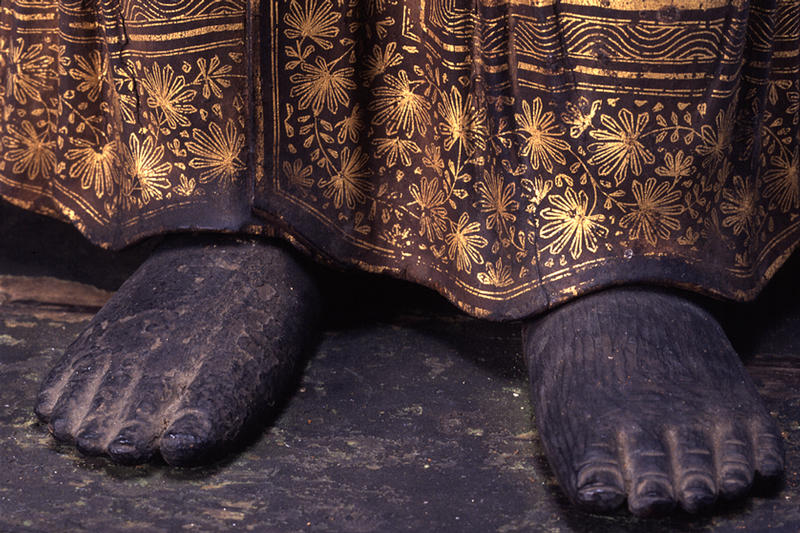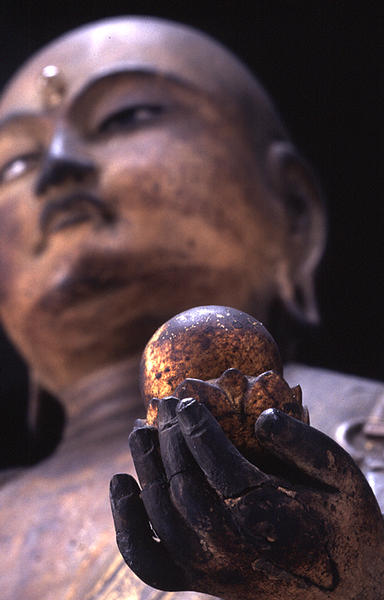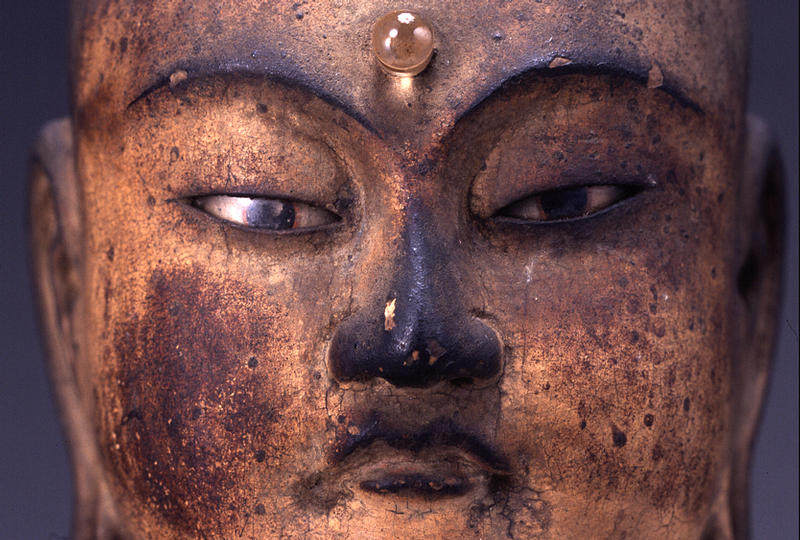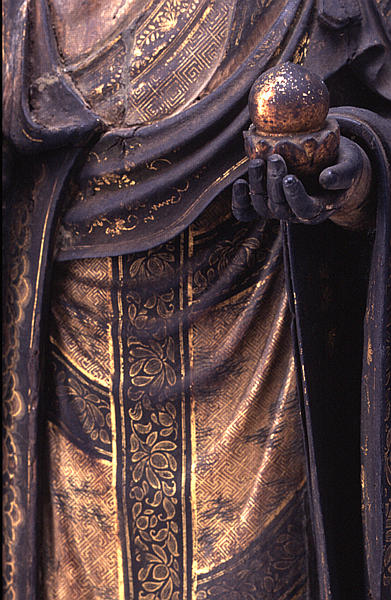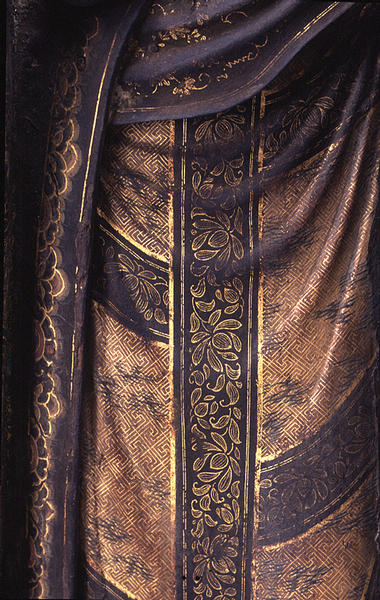地蔵菩薩立像
- 鎌倉時代
- 13c
- 木造(桧、寄木造)彩色、玉眼、截金
- H-52.4
- 所蔵
- 重要文化財
地蔵菩薩立像 鎌倉時代 13世紀 重要文化財 木造彩色
地蔵は遠い将来に弥勒仏が現れて人々を救済されるまでの間、自らの業に苦しむ衆生の身代わりとなって現在の私達を救って下さる菩薩である。このような思いを昔の人も持っていたのであろう。お地蔵さんは常に身近な存在であり、石や木で様々なお地蔵さんが彫られてきた。
この地蔵菩薩像は、水晶をはめ込んだ鋭いまなざしが表情にはっきりした意志を与えると共に、一面どことなくやんちゃ坊主のような愛敬のある顔立ちをしている。平安時代後期まで、貴顕の気に入る美しい顔立ちの仏像を造立する事に専心していた彫刻界だが、このような写実的・個性的な像が制作され始めたのは、鎌倉の新鮮な空気に触れて起こった様々な展開のうちの一つである。
この像は、細かい木取りで制作された全体のプロポーション、衣紋のたわみの重さ、裾の自然な広がりと揺れに優れた彫技が見られる。衣に表わされた金泥・切金の文様6~7種、更に彩色で表わされた数種の装飾は精緻である。彩色法は白土下地を置いた本格的なもので台座のバランスも良く、小像ながら鎌倉彫刻を代表する逸品と言えよう。
地蔵
地蔵
釈迦仏の死後、弥勒菩薩が人々を救うまでの間、この世に現れて人々を救う菩薩。特に左手に宝珠、右手に錫杖を持つ僧形の姿が親しまれた。
地蔵信仰は中国では唐代、わが国では平安時代以来あったが、特に鎌倉時代以後、現世ばかりか六道、地獄の救済者として民間に広く信仰され、六地蔵の造像や賽の河原の児童の救済を讃える和讃などに、人々の地蔵信仰の様を伺うことができる。
地蔵菩薩鏡像
解説2
鎌倉時代 13世紀
木造彩色,截金
像高:52.4cm
地蔵菩薩は,釈迦の没後から弥勒が成道するまでの長い間,すなわち無仏時代において人びとを済度する役割をになっているとされる。したがって,菩薩でありながら剃髪した僧侶の姿をとる。平安時代以降,右手に錫杖を執る像が多くなったのも,この菩薩が浄土に住まず,この世に留まりつづけて遊行しているという信仰に基づくからにほかならない。
本像は左手に宝珠,右手に錫杖を執るという一般的な像容で,現世遊化という性格から左足を半歩踏み出して歩行の姿を表している。
ヒノキを用材とした寄木造の構造になるが,その木寄せ法は小像にしては大変に細かい。およその構造は,頭・体部は前後二材からなり,さらに頚部下と胸部襟際で割り放つ。面相部は別材を仮面状に矧いでおり,刳りぬかれた目の部分にはその内側から水晶をあてて,玉眼としている。両体側部や両手先・両足先も別材を矧いでいる。この像でとくに注目されるのが,着衣に施された豊富な文様である。切金(金箔を細く切ったもの)により,雷文繋ぎ,麻葉繋ぎ,卍繋ぎ,唐草などを表し,その間に表される彩色文様は金泥で括られる。
顎の張った面相部に,切れ長で見開きの強い目を配し,意志的な面貌としており,着衣部の華麗な文様と相まって,現世の救主らしい現実感を出している。像容・着衣文様ともに,鎌倉時代後半の典型的な作例である。(伊東)
Catalogue Entry
Kamakura period, 13th century
Assembled wood with polychrome
Figure height, 52.4cm
Jizo acts to save people during the long Buddha-less age which extends between the death of Shaka (S⇔akyamuni) and the coming of Miroku (Maitreya). As a result, this deity is a Bosatsu (Bodhisattva), and yet he wears the shaved head of a monk. Many images of this deity from the Heian and later periods show him holding a staff in his right hand. This staff is based on the belief that this deity does not reside in the Pure Land, but rather remains active in this world.
The present image holds a jewel in his left hand and a staff in his right hand, forming the standard iconography of this deity, and he is also placed in the one-foot-slightly-forward pose to indicate his walking in the present world.
This image is made of hinoki (Japanese cypress) carved in the yosegi zukuri form of joined construct, but the joining method is extremely intricate and follows that of small images. In general, the head and body area is formed from two pieces of wood joined front to back, and the neck and collar area of the chest have been split. The face is a separate piece of wood dovetailed on in a mask-like fashion, while crystal has been inset into the carved eye areas to form crystal eyeballs. Both sides of the figure, both hands, and both feet have been carved from separate pieces of wood which were then dovetailed onto the central core. The rich patterning that adorns the drapery is particularly noteworthy on this image. Cut gold leaf (in which gold leaf is cut into thin strips) is used to form linked-vajra patterns, linked-hemp leaf patterns, linked-swastika patterns, karakusa vining plant motifs, and other decorative forms. The polychrome patterns that appear between these linked chains were outlined in gold paint.
The taut-checked face is dominated by the sharp gaze of the long eyes, forming an intent expression. The lavish patterning of the clothing motifs gives the image a sense of realism appropriate to his role as a savior in the real world. Both the image itself and the drapery patterns are typical examples of the styles prevalent during the second half of the Kamakura period. SI
